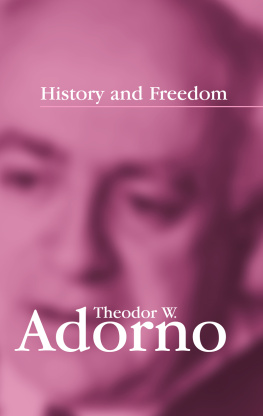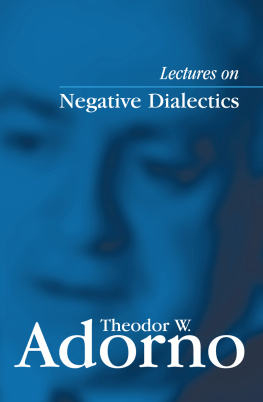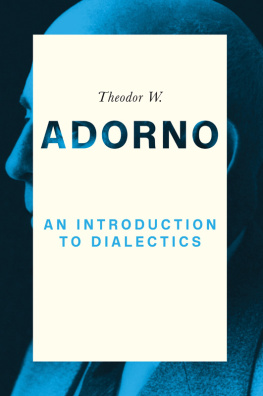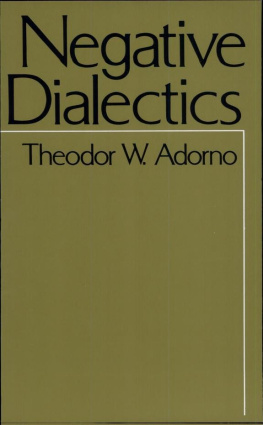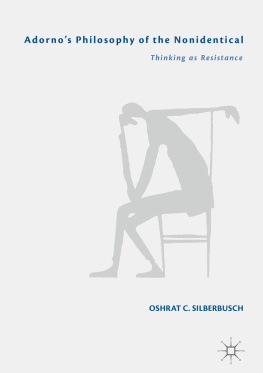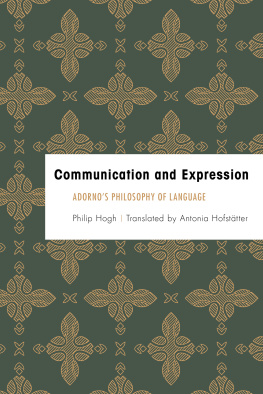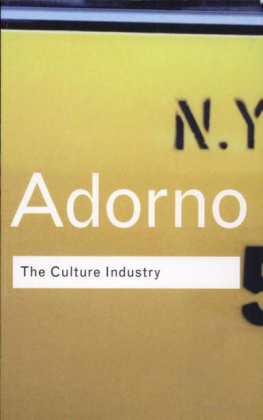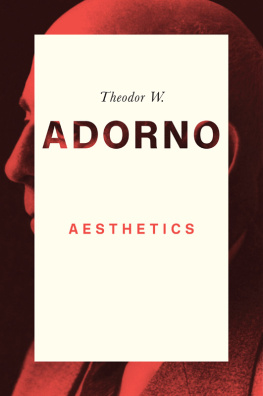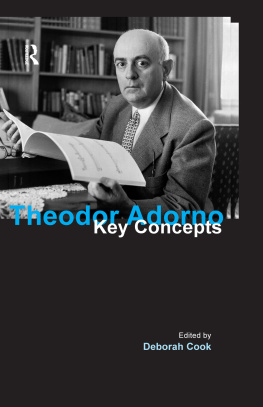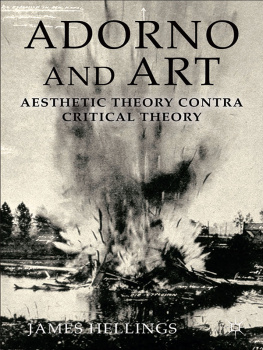
Critical Models Interventions and Catchwords
European Perspectives
E UROPEAN P ERSPECTIVES
A Series in Social Thought and Cultural Criticism
Lawrence D. Kritzman, Editor
European Perspectives presents outstanding books by leading European thinkers. With both classic and contemporary works, the series aims to shape the major intellectual controversies of our day and to facilitate the tasks of historical understanding.
For a complete list of books in the series, see .
Critical Models Interventions and Catchwords
Theodor W. Adorno
Translated by Henry W. Pickford
Introduction by Lydia Goehr
Columbia University Press New York
The Press gratefully acknowledges a grant from Inter Nationes toward costs of
translating this work.
Columbia University Press
Publishers Since 1893
New York Chichester, West Sussex
cup.columbia.edu
Eingriffe: Neun kritische Modelle copyright 1963 by Suhrkamp Verlag,
Frankfurt am Main
Stichworte: Kritische Modelle 2 copyright 1969 by Suhrkamp Verlag,
Frankfurt am Main
Translation copyright 1998 Columbia University Press
Introduction copyright 2005 Columbia University Press
All rights reserved
E-ISBN 978-0-231-51042-4
Library of Congress Cataloging-in-Publication Data
Adorno, Theodor W., 1903-1969.
[Eingriffe. English]
Critical models : interventions and catchwords / Theodor W. Adorno;
translated by Henry W. Pickford; introduction by Lydia Goehr.
p. cm.(European perspectives)
Includes bibliographical references and index.
ISBN 0-231-13504-1 (alk. paper)ISBN 0-231-13505-X (pbk. : alk. paper)
1. Social history20th century. 2. Social sciencesPhilosophy. I. Pickford,
Henry W. II. Adorno, Theodor W., 1903-1969. Stichworte. English. III. Title.
IV. Series.
HN16.A3313 2005
301'.01dc22
2005049777
A Columbia University Press E-book.
CUP would be pleased to hear about your reading experience with this e-book at .
Contents
Appendix 1: Discussion of Professor Adorno's Lecture
The Meaning of Working Through the Past
Appendix 2: Introduction to the Lecture
The Meaning of Working Through the Past
Translators are the post-horses of enlightenment.
Pushkin
The present volume is a critical edition of the two essay collections Adorno subtitled critical models and is based on the texts in the second part of volume 10 of his collected writings ( Gesammelte Schriften: Kulturkritik und Gesellschaft II , edited by Rolf Tiedemann [Frankfurt: Suhrkamp, 1977]). Eingriffe: Neun kritische Modelle , was published in 1963 as volume 10 in the series edition suhrkamp; although Adorno had corrected the galleys, the second volume, Stichworte: Kritische Modelle 2 , did not appear until shortly after his unexpected death in 1969, as volume 347 in edition suhrkamp. Also included here from volume 10 of the collected writings are two very late essays, Critique and Resignation, which Adorno had set aside for an eventual third volume of critical models, and an introduction to the lecture The Meaning of Working Through the Past. Finally, this edition provides a translation of the discussion between Adorno and his audience when he first gave this lecture; the discussion transcript was included in the essays initial publication though not in the subsequent book edition or in the collected writings. This document offers a vivid portrait of Adorno in the role of public intellectual, explicating himself ad hoc about what could be considered the practical motive of these essays: to promote political maturity by bringing reified consciousness to self-awareness. The purposefulness of that intention transcends the contingency of the occasions for which Adorno wrote many of these texts.
For the context underlying the genesis and development of these essays is Adornos enormous role as a public philosopher and cultural critic following his return to Germany in 1949. Indeed, with the publication of Minima Moralia in 1951 Adorno became virtually a popular author; in a letter to his friend and early mentor, Siegfried Kracauer, he ascribed his surprising success to a fortunate conjunction of a general cultural vacuum and the waning interest in Heideggerian themes and reveled in the freedom his new fame afforded him. Incomplete documentation indicates that between 1950 and 1969 Adorno participated in more than 160 radio programs. While the medium of course lent itself to Adornos reflections on music, the overwhelming majority of his contributions was broadly intellectual, just as most of the essays collected here began as radio lectures. The Adorno emerging here is a far cry from the stereotypical mandarin aesthete; as his editor at Hessischer Rundfunk in Frankfurt recounts, Adorno told him:
I want to be understood by my listeners... [Adorno] thought that I, as an expert, knew better how to achieve that. It was, surprisingly, of the utmost importance that he be understood even and especially in a medium of the culture industry. The sound technicians who were responsible for recording him afterward had to repeat spontaneously and in their own words what he had said, and often there ensued a discussion that was much better and more comprehensible than the lecture he had just read into the microphone. We had to take care that when he came to the radio station, there were appropriate sound technicians who were able to justify their answers to him. It was preferable to postpone a session rather than Adorno having to forego the important discussion afterward with our assistant. Once we recorded one such discussion between Adorno and his sound technician without him or her noticing, and then played it back to them. He found himself surprisingly good, which meant a great deal in consideration of his demanding conceit, his pronounced skepticism toward the mass media, and his general aversion for organizations and institutions that shape opinion.
Although at times he seemed to dismiss these lectures as modest bagatelles and occasional pieces quickly dispatched, The concrete recommendations incorporated into several of these essays were meant as direct interventions; for example, along with other leading cultural figures Adorno was asked in 1969 for his position on the continued illegality and persecution of homosexuality in West Germany. The published anthology of responses included these introductory remarks to an extract from the essay Sexual Taboos and Law Today:
Kindest thanks for your lovely letter. What I have to say on the topic of sexual morality, in the most diverse spheres of the harm that it wreaks, can be found in the essay Sexual Taboos and Law Today in Interventions , and in Morals and Criminality in the third volume of Notes to Literature . Both works I sent immediately to Dr. Heinemann as soon as he took over the Ministry of Justice, asking him to read them in the context of plans to reform the penal law, and I received an extremely friendly response. At the moment I wouldnt know what to add to what I have written there. That I most fiercely oppose every kind of sexual repression should in the meantime be more or less common knowledge, which I gladly confirm explicitly to you.
In these essays perhaps more than anywhere else in his compendious oeuvre are the practical and political motivations of Adornos thought most visibly at work.
Those motivations in turn shape the structure and style of critical models: specific analyses that tactically employ the negative dialectical strategy he expounded and exemplified with three thought models in Negative Dialectics , by which a phenomenon or concept pretending to self-sufficient immediacy is discursively unmasked as a societally mediated, historical result. Present conditions are shown to contradict the reigning ideology, andrather than being discarded for not representing realitythe ideology is taken at its word, as the as yet unfulfilled promise of its realization.
Next page

